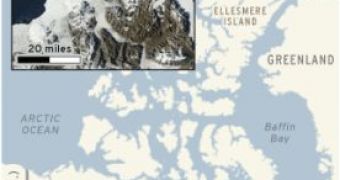The dramatic ice shelf breakages observed in the last years in Antarctica and Greenland keep on extending further and further on the North Pole area.
A giant ice shelf has broken out free from an island south of the North Pole, in the Canadian Arctic.
Satellite images alerted that the Ayles Ice Shelf, about the size of Manhattan, freed itself 16 months ago from the coast of Ellesmere Island, about 500 miles (800 km) south of the North Pole.
The shelf formed a new ice island, leaving a trail of icy floating boulders.
"This is a dramatic and disturbing event. It shows that we are losing remarkable features of the Canadian North that have been in place for many thousands of years," said Warwick Vincent of Laval University.
"We are crossing climate thresholds, and these may signal the onset of accelerated change ahead."
The ice shelf was one of the six major ice shelves in Canada's Arctic, formed by 3,000 years old ice.
Ice shelves float on the sea but are binded to land.
This is the largest event of this type in Canada in nearly 30 years.
"It is consistent with climate change," said Vincent.
"We aren't able to connect all of the dots ... but unusually warm temperatures definitely played a major role."
Laurie Weir, who monitors ice conditions for the Canadian Ice Service, noticed in 2005 that the shelf had split and separated in satellite images.
Satellite images and seismic data (the event registered on earthquake monitors 155 miles (250 km) away) allowed Luke Copland, head of the new global ice lab at the University of Ottawa, to estimate that the ice shelf collapsed in the early afternoon of Aug. 13, 2005.
The speed with which climate change has affected the ice shelves has taken by surprise the scientists.
"Even 10 years ago scientists assumed that when global warming changes occur that it would happen gradually so that perhaps we expected these ice shelves just to melt away quite slowly," he said.
"Instead, satellite images showed the 9-mile (14 km) long crack, then the ice floating about a half mile from the coast within about an hour," Copland said.
"You could stand at one edge and not see the other side, and for something that large to move that quickly is quite amazing," he said.
The event was perhaps due to a combination of low accumulations of sea ice around the mass' edges as high winds blew it away and unusual warm temperatures.
"The region was 5.4 degrees F above average in the summer of 2005," he said.
"Ice shelves in Canada's far north have decreased in size by as much as 90 % since 1906, and global warming likely played a role in the Ayles break," Copland said.
"It's hard to tie one event to climate change, but when you look at the longer-term trend, the bigger picture, we've lost a lot of ice shelves on northern Ellesmere in the past century and this is that continuing," he said.
"And this is the biggest one in the last 25 years."
"The ice shelves get weaker and weaker as temperatures rise." said Derek Mueller, a polar researcher.
In 2002, he noticed that another ice shelf on Ellesmere Island had cracked in half.
"We're losing our ice shelves and this is a feature of the landscape that is in danger of disappearing altogether from Canada," Mueller said.
In a few days after breaking off, the Ayles Ice Shelf drifted about 30 miles (50 km) offshore before freezing into the sea ice.
Spring thawing will free the new ice island from its grip, making it extremely dangerous for ships.
"Over the next few years this ice island could drift into populated shipping routes," Weir said.
Image credit: NASA.

 14 DAY TRIAL //
14 DAY TRIAL //